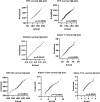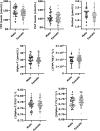Optimizing vitamin supplementation via reference interval update of vitamins A, E, B1, and B6 using HPLC
- PMID: 40151408
- PMCID: PMC11936734
- DOI: 10.3164/jcbn.24-155
Optimizing vitamin supplementation via reference interval update of vitamins A, E, B1, and B6 using HPLC
Abstract
Vitamins are essential micronutrients obtained from the diet, required by the body in small amounts daily for proper metabolism. Monitoring their levels is necessary for detecting deficiencies and guiding supplementation in certain clinical conditions. This study aimed to update the reference values for vitamins A, B1, B6, and E, and some related ratios, adjusted to the adult population of our health reference area using liquid chromatography in a direct approach calculation (n = 146, age: 21-64 years, 64% females). No significant differences in vitamin levels or ratios were observed based on age and sex. We obtained reliable and updated reference values: 1.1-2.8 μmol/L and 18.9-42.2 μmol/L for vitamins A and E respectively, 85.9-181.6 nmol/L and 57.0-165.7 nmol/L for vitamins B1 and B6 respectively; and related ratios of 246.2-561.1 ng/g for vitamin B1 corrected by hemoglobin; 5.2-8.9 μmol/mmol and 4.5-7.4 μmol/mmol for vitamin E corrected by cholesterol and total lipids, respectively. These reference values significantly differ from those provided by the reagent manufacturer currently in use. While correcting vitamin E for lipids and vitamin B1 for hemoglobin is not recommended for the general population, these adjustments may be useful in interpreting results in certain pathological conditions.
Keywords: HPLC; clinical nutrition; reference value; vitamin status correction; vitamins.
Copyright © 2025 JCBN.
Conflict of interest statement
No potential conflicts of interest were disclosed.
Figures




References
-
- Doyle K, Bunch DR. Reference intervals: past, present, and future. Crit Rev Clin Lab Sci 2023; 60: 466–482. - PubMed
-
- Ozarda Y, Higgins V, Adeli K. Verification of reference intervals in routine clinical laboratories: practical challenges and recommendations. Clin Chem Lab Med 2018; 57: 30–37. - PubMed
-
- Martinez-Sanchez L, Marques-Garcia F, Ozarda Y, et al. Big data and reference intervals: rationale, current practices, harmonization and standardization prerequisites and future perspectives of indirect determination of reference intervals using routine data. Adv Lab Med 2020; 2: 9–25. - PMC - PubMed
-
- Ma S, Yu J, Qin X, Liu J. Current status and challenges in establishing reference intervals based on real-world data. Crit Rev Clin Lab Sci 2023; 60: 427–441. - PubMed

